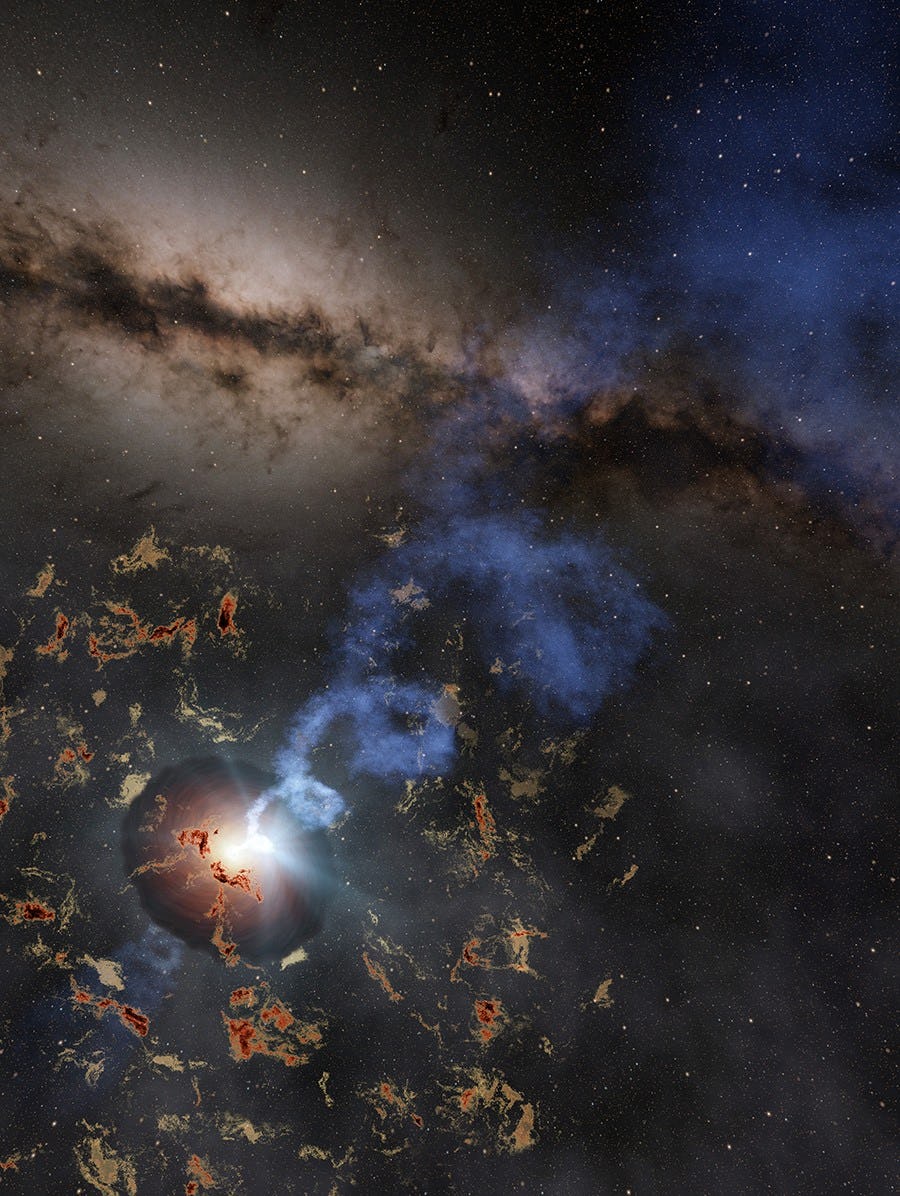
The universe is full of stupendously huge explosions. Gamma ray bursts in distant galaxies are literally an everyday sight, and supernovae are even more common as astronomers observe hundreds every year.
But one type of cosmic cataclysm is the rarest and most mysterious. These are sudden, intense burst of mostly bluish light (which flares even brighter than a supernova for just a few days before disappearing), and astronomers call them luminous fast blue optical transients (LFBOT). Only seven have been spotted since 2018, and one of them recently did something very strange, even by LFBOT standards. After the original burst had faded, the LFBOT flared up again — not once but several times.
Cornell University astronomer Anna Ho and her colleagues hope that studying this strange behavior may help shed some bright, blinking light on what causes LFBOTs in the first place, and their latest work was published this week in the journal Nature.

A Never-Before-Seen Phenomena
Ho and other astronomers spotted this strange LFBOT, nicknamed “the Tasmanian Devil” (due to the last letters of its official designation AT2022tsd), at the Zwicky Transient Facility at the Palomar Observatory in southern California. This facility has a camera mounted on a telescope that scans the entire night sky every few nights, looking for any sources of light that suddenly appear, disappear, or change. Any LFBOT detection is a big deal because astronomers have seen so few of these terribly bright explosions and know so little about what causes them.
A couple of months after LFBOT’s initial detection, Ho and her colleagues were tracking its lingering afterglow of ultraviolet and radio waves when suddenly, the same spot in space lit up again, fading away in only a few minutes.
Ho and her team enlisted the help of astronomers at more than a dozen other telescopes around the world, and within the first three months after the first LFBOT, the Tasmanian Devil flared again at least 14 times (though the team suspects they missed a few). Unlike the LFBOT, these flares were reddish and faded away much more quickly, Ho tells Inverse, but they were undeniably coming from the same source.
“We had never seen anything like that before — something so fast, and the brightness as strong as the original explosion, months later — in any supernova or FBOT. We’d never seen that, period, in astronomy,” says Ho in a recent statement. “LFBOTs are already a kind of weird, exotic event, so this was even weirder.”
And that extra weird aftermath may help narrow down what causes LFBOTs in the first place.

A Cosmic Smoking Gun?
Astronomers don’t agree on what causes LFBOTs, but the leading ideas all seem to involve something horrific happening to a star. LFBOTs may be a previously unknown type of supernova, caused by the fiery death throes of an especially enormous star, or they may also be the result of a massive star falling headlong into a black hole. But this new paper suggests that the strange flares they saw last fall offer at least one clue: whatever is powering these cataclysmic explosions has to leave behind either a black hole or an extremely magnetic neutron star called a magnetar.
The wavelengths of light in the flares, along with how quickly their brightness changes, suggest that it likely involves a relativistic jet. This type of ionized outflow produces a beam of electrically charged particles blasting away from a black hole or a neutron star at nearly the speed of light. Usually sped along by absurdly powerful magnetic field lines, relativistic jets eventually move away from their source, and the particles release a huge amount of energy in the form of radiation.
Only two types of objects in the universe are known to produce these jets: black holes and magnetars. And if LFBOTs leave behind one of these two objects, that narrows down the type of event that causes them. The first option is that astronomers are catching a rare glimpse of a phase of stellar evolution: a weird, flare-prone phase that happens after a star explodes, but before it settles into its afterlife as a neutron star or black hole.
But another possibility is that LFBOTs are the explosive result of a collision between a star and a neutron star or black hole.
“That would mean that the black hole or neutron star was not formed in the LFBOT event, but already existed,” Ho tells Inverse. “In that case, the LFBOT was the event that ‘activated’ the neutron star/black hole and caused it to start flaring.”
The Waiting Game
For now, the Tasmanian Devil is quiet.
“As far as we can tell, the flares have stopped, but we actually don't know that for sure – we're continuing to observe the source now to confirm this,” says Ho. “If they did stop, that means the object powering them ran out of energy. For example, if the object is a black hole and was powering the flares by accreting matter, it might have run out of matter to accrete (run out of fuel).”
Ho and her team are still keeping an eye on that particular patch of sky, but they’re also searching the locations of other recent LFBOTs for similar flares. If these explosions of light really are the result of relativistic jets, whether we can see them from Earth depends on whether the jets are pointed in our direction. That could explain why astronomers have never seen an LFBOT do anything like this before, but to know for sure, astronomers will just have to wait and see.







